For some, using margins as a reference is critical when working on a document. If you are one of those people, you may end up asking yourself pretty quickly – “how to set up margins in PowerPoint!”
PowerPoint, by default, doesn’t have an option to set up margins on a slide in order to define where the text begins and ends. However, a workaround to that is using guides as reference points which can help overcome the lack of margins in PowerPoint and give a consistent look to your presentation.
This article will explain the process of setting up margins using guides in PowerPoint in complete detail in addition to answering a few important margin-related questions (including margins for printing).
A Quick Note Before We Begin – if you want to make jaw-dropping presentations, I would recommend using one of these Presentation Designs. The best part is – it is only $16.5 a month, but you get to download and use as many presentation designs as you like! I personally use it from time-to-time, and it makes my task of making beautiful presentations really quick and easy!
How to Set Up Margins in PowerPoint?
Setting up margins in PowerPoint can seem really difficult at first as there is no direct option provided by Microsoft. Thus, users who are used to a one-click access for setting up margins in other softwares, such as Microsoft Word, find it difficult to do so in PowerPoint.
Fortunately, using Guides is a simple workaround and an easy fix to this problem.
Let’s understand the process of using Guides and setting it up as margins on a PowerPoint slide.
Step 1 – Enable Guides for your PowerPoint Presentation
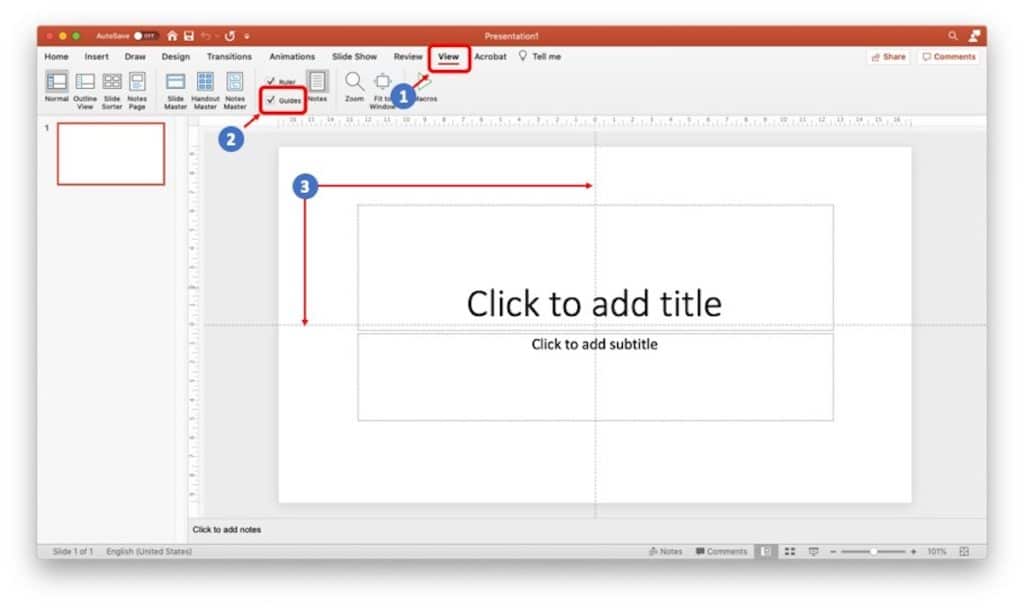
The first step is really to enable guides in your PowerPoint presentation.
Some of you may see the guides on your slides by default. However, if you don’t see it, use the following steps to enable it –
- Open a blank presentation. Click on the “View” button in the Menu Bar on top (as indicated by “1” in the image above)
- Next, look for the “Guide” option. It will be close to the “Ruler” option in the View tab. Once you locate the guide option, make sure you check the box in order to enable it.
- Lastly, to ensure that the Guides are visible on the slide, verify that you have 2 dotted lines crossing each other in the middle of the slide.
Step 2 – Create Additional Guides for the Margin
Next, we want to make sure that we have enough dotted guide lines present on the canvas of the slide such that we can create an appropriate margin.
A margin to a document is basically a border on all four sides. Thus, we need at least 4 dotted ‘guide’ lines to create a margin – one each on the left, right, top and bottom.
When you enable guides on your PowerPoint, there would be 2 lines present on your slide by default. As we need 4 guides to create a margin for our document, we’ll need to add more guides.
For the purpose of this example, I’ll be creating additional 4 guides apart from the 2 that are already existing on the slides.
In order to do this, make sure you go through the following steps –
Step 2.1 – Hover Over the Vertical Guide
First, bring your cursor and hover over the vertical ‘guide’ line until it turns into a cross-arrow.
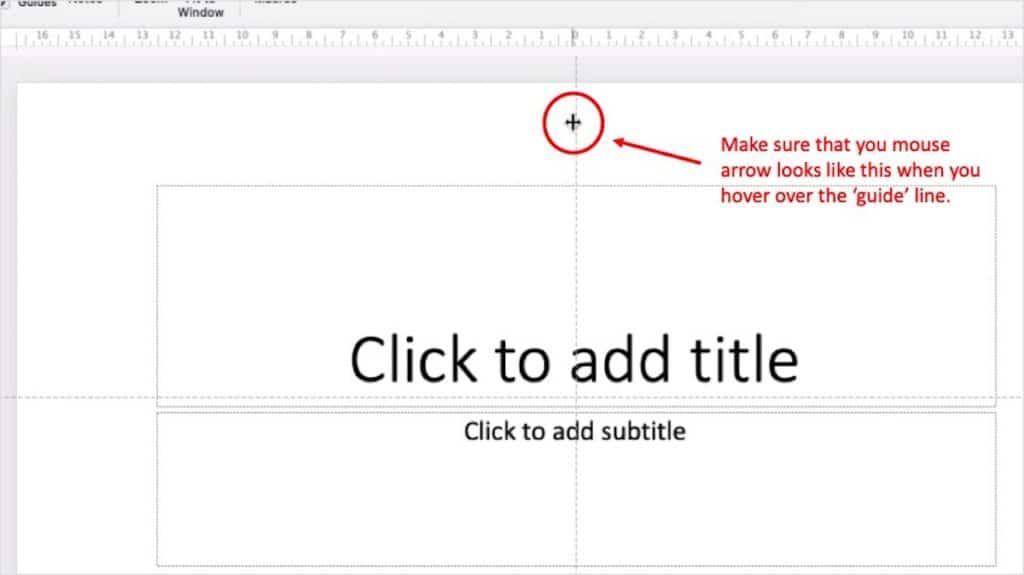
Step 2.2 – Right Click and Add two Vertical Guides
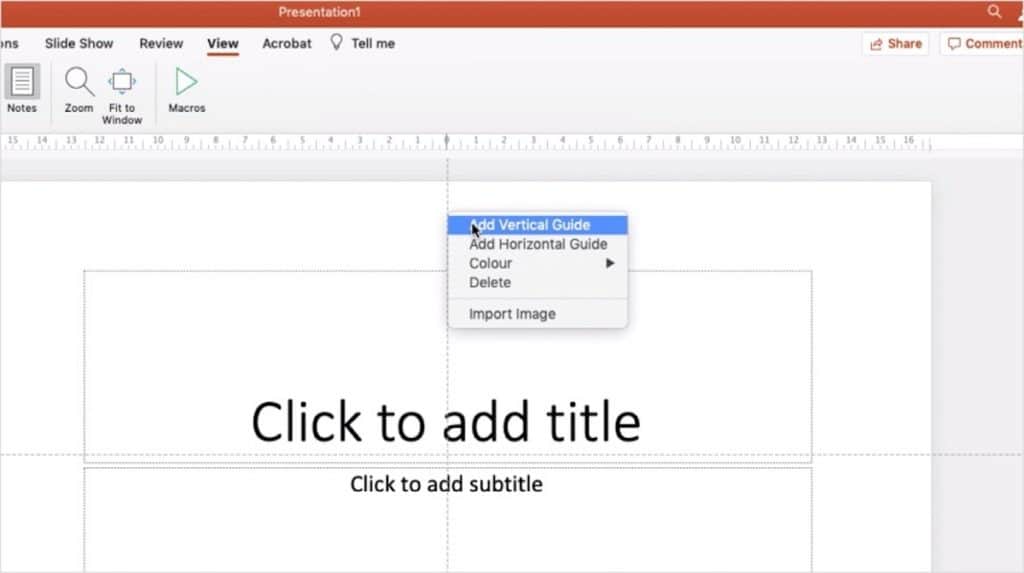
The next step is to add two vertical ‘Guide’ lines to your slide.
The easiest way to do so is to right click on the guide, and then select “Add Vertical Guide” as showcased in the image above.
Another way to quickly add a guide to the slide is by holding Ctrl+Shift keys (Cmd+alt+Shift on Mac), and then dragging guide in one direction. This will duplicate a guide on PowerPoint.
We will repeat the process to add another vertical guide (as we need 2 vertical guides and 2 horizontal guides).
We will then follow the same process for the horizontal guides as well and add 2 horizontal guides on the slides.
Step 3 – Move the Guides to Set up the Margin in PowerPoint
Alright, if you’ve gotten this far, you’ve already done most of the work. But, this step is pretty crucial too.
Once you have all the 4 additional ‘guides’ lines added, it is time we move it towards the four edges of the slide on PowerPoint to create our margin.
You need to do the following steps to set up margins in PowerPoint.
Step 3.1 – Set up the Vertical Margins on a PowerPoint Slide

First, move both the vertical guides to the left and right side of the presentation slide.
Make sure that they are equidistant from the edges of the slides. For this example, I’ve set my vertical slides at 15.70 on both the sides of the slide (as you may be able to see in the above image).
You’ll notice that as you drag your guides, a dynamic number will appear along with the slides. This number indicates the distance the guide is from the centre of the slide.
No matter what value you choose to go with, make sure that both your vertical slides are at the same distance away from the center in order to get a perfect rectangular canvas.
Step 3.2 – Set up the Horizontal Margin on a PowerPoint Slide
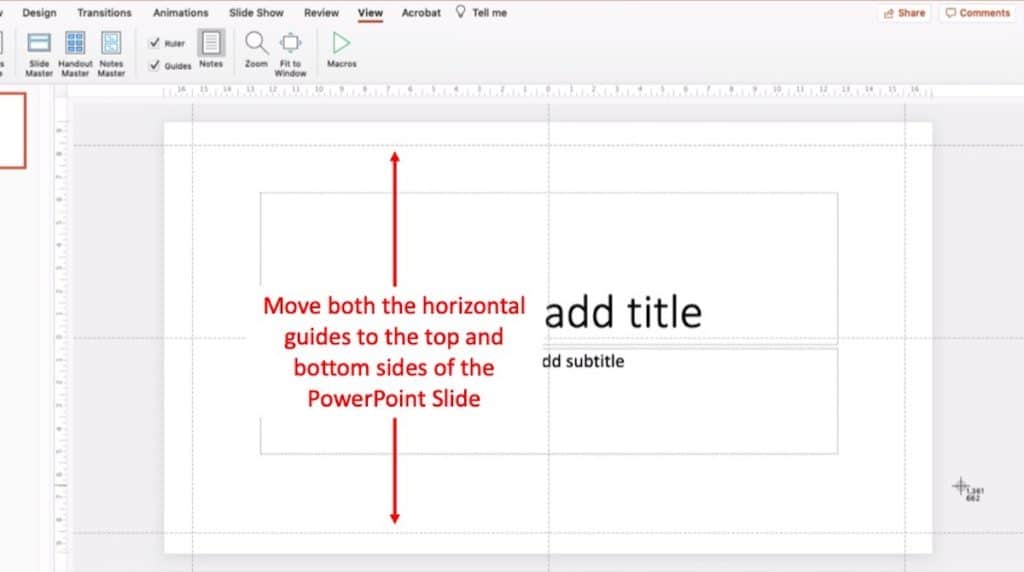
Now that you have your vertical margins in place, you basically need to repeat the process to put your top and bottom margins in place as well.
For this example, I’ve set my horizontal margins at 8.5 both at top and bottom.
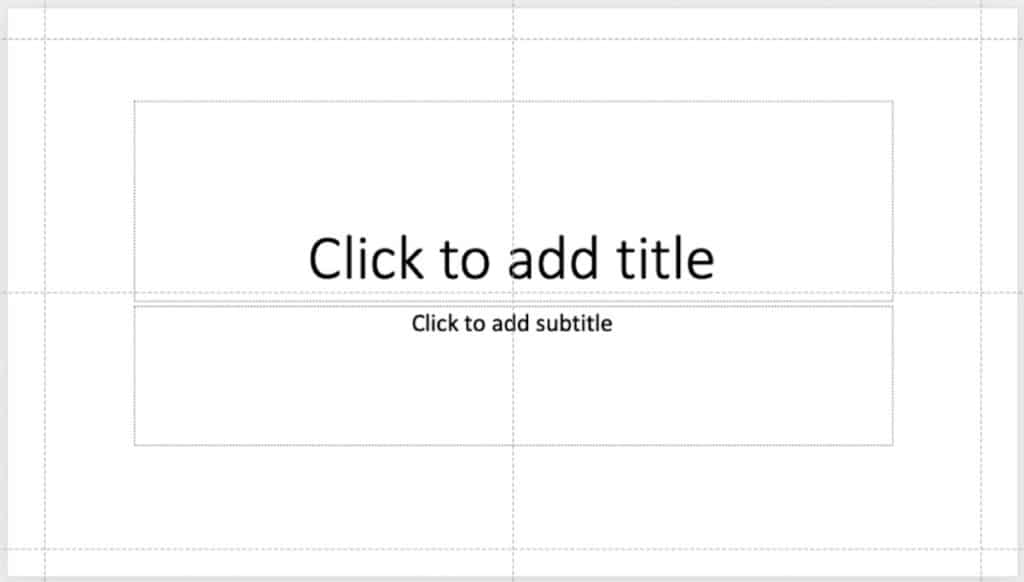
Voila, you now have margins set for your PowerPoint slide with a just a few modifications!
Now all you need to do is just insert a text box between both the vertical and ‘guide’ lines and it will all be aligned.
The cool part is that PowerPoint allows you to auto-snap shapes and other elements to align with the guides. This means, when you bring a shape closers to one of the guides, it automatically sticks to the guide and perfectly aligns with other objects!
Doing this in the Master Slide can make sure that you have margins in all your slides throughout your presentation.
Why Do you need Margins for PowerPoint?
Even though we have managed to set up margins on a PowerPoint slide in the above steps, an immediate question that pops-up for most people is “Why do we need margins for PowerPoint?”.
More so, if it is so important to have margins, why doesn’t Microsoft PowerPoint provide a one-click option to add and adjust margins just as it does in Microsoft Word?
To truly understand this, we need to understand what purpose do margins serve in a document.
A margin primarily serves the following two purposes –
- Setting boundaries of the content on a document – that is to know the start and end points for the text and other pieces of content in a document.
- Printing a document – margins help in ensuring that parts of the content don’t get cut out while printing a physical copy of the document.
PowerPoint is a software that is used for design purposes. It is a software that is empowered to create digital documents as opposed to other software tools, such as Adobe InDesign, which are focused around digital tools for physical documents.
Thus, the reason PowerPoint doesn’t provide with an in-built option to adjust margins is that most digital documents don’t need bleed margin. Additionally, content elements within PowerPoint such as text boxes are quite flexible and the width can be adjusted easily.
Moreover, PowerPoint adds a default white space around the slides when printing a document.
How to Change the Margins in PowerPoint?
In order to change the margins in PowerPoint, make sure that you first have the guides enabled, added and set up such that it serves as margin for your content on the slide.
This can be done using the steps described above.
Once the guides are setup as margins in PowerPoint, changing the margins is quite easy.
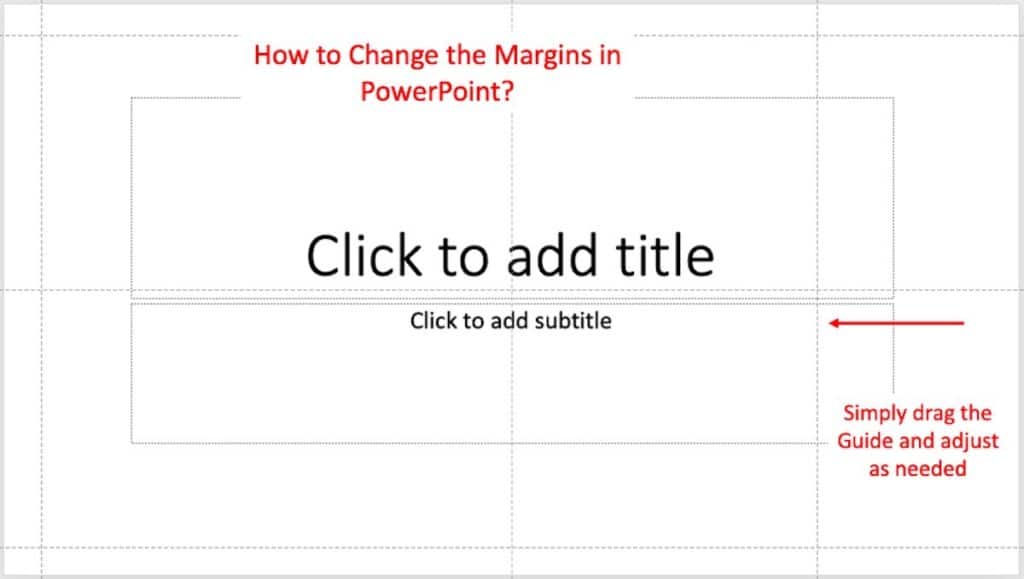
All you need to do is simply drag the guides from the four corners and adjust them as per your needs in order to change the margins in PowerPoint.
However, it is important to note that upon changing the guides, the content will NOT adjust accordingly automatically as there are no margin options provided by default in PowerPoint.
You will have to manually adjust all the content on the slides once again as per the revised positions of the guides.
That said, I can’t think of any reason why one would need to really change the margins drastically in PowerPoint.
How to Access Page Setup for Printing in PowerPoint?
Accessing page setup is easy in PowerPoint. There are at least 2 methods of accessing the page setup menu in PowerPoint.
The following steps describe the process to do the same –
Method 1 – Using the “File” Option
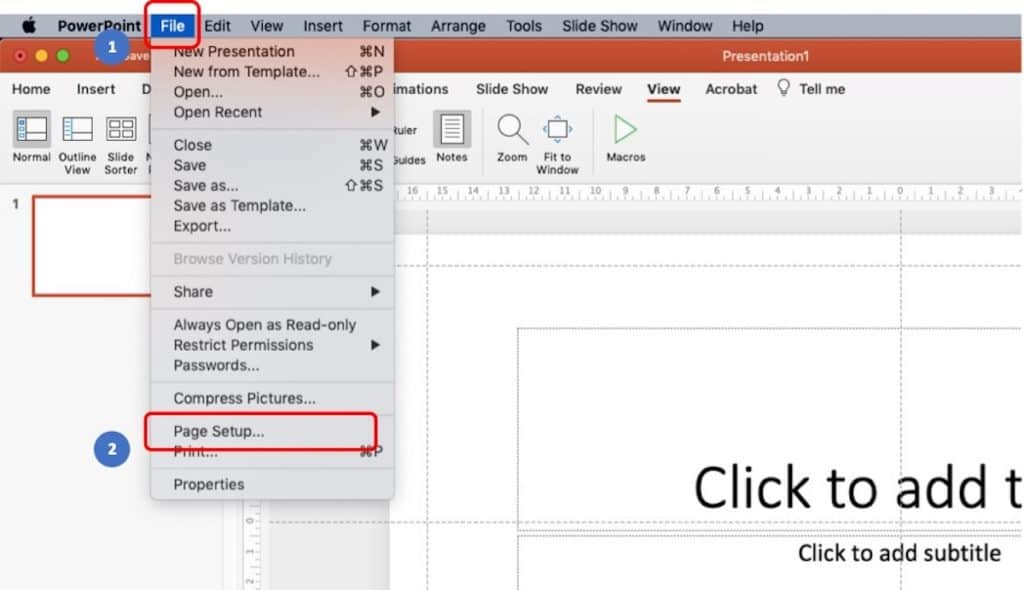
The first method is using the “File” option from you PowerPoint Menu bar.
Click on “File”. Then, locate and click on “Page Setup”.
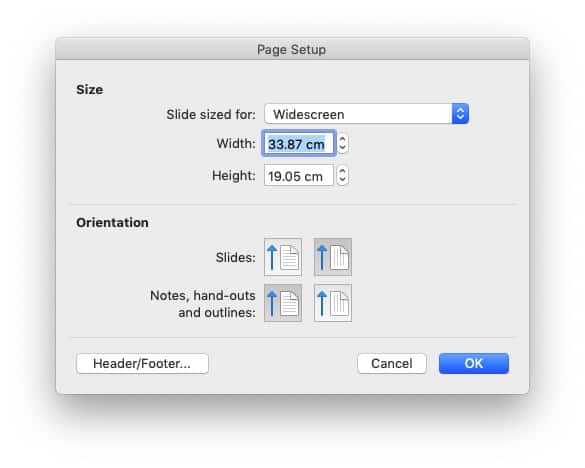
You will notice that the “Page Setup” menu in PowerPoint opens up.
Note –
Although the above images showcase options for a PowerPoint on Mac, the steps for Windows PC are pretty much the same.
Once the page setup menu opens up, you can change the orientation of the slide to portrait or landscape, and make several other changes including the exact requirements for printing your presentation.
Method 2 – Using the “Design” Tab
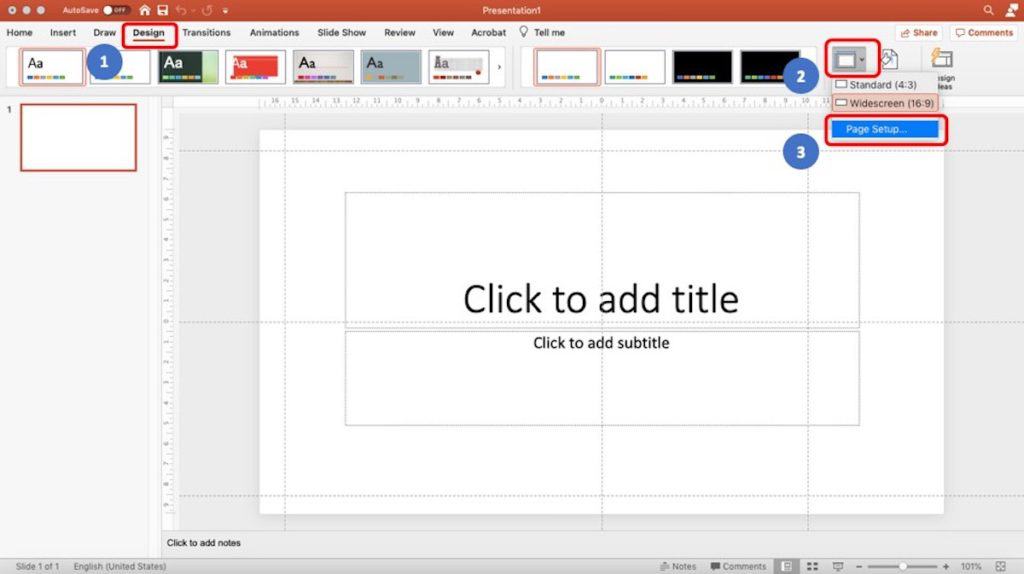
Another method is by using the “Design” Ribbon.
Simply click on “Design“, then click on “Slide Size“, and locate the “Page Setup” option in the dropdown menu that opens up.
Upon selecting the page setup option, a similar window opens up as indicated in method 1.
How to Print Slides without any Margins or White Border?
As mentioned above in the article, since PowerPoint doesn’t have in-built options to adjust the margins directly, it puts a default margin in the form of a white border around your slides.
You will notice this when you try and print your slides or save it as a PDF file. The output file will almost always have a default white border around your slides.
So, how does one get rid of this white border?
Here’s a video that explains how to fix this problem –
While there is no straightforward method to fix this issue, there is a workaround as explained in the video above.
Again, while the video shows how to fix this issue on a Mac, the process for a Windows PC is the same.
How to Change the Print Layout in PowerPoint?
You can change the print layout in PowerPoint directly by accessing the page setup options and then choosing either portrait or landscape print layout.
To access the “Page Setup” window, follow the steps mentioned earlier in this article.

In the Page Setup window in PowerPoint, choose the type of layout for printing as indicated in the image above.
You can also change the print layout through the “Print” options by pressing Ctrl+P (or Cmd+P on Mac).
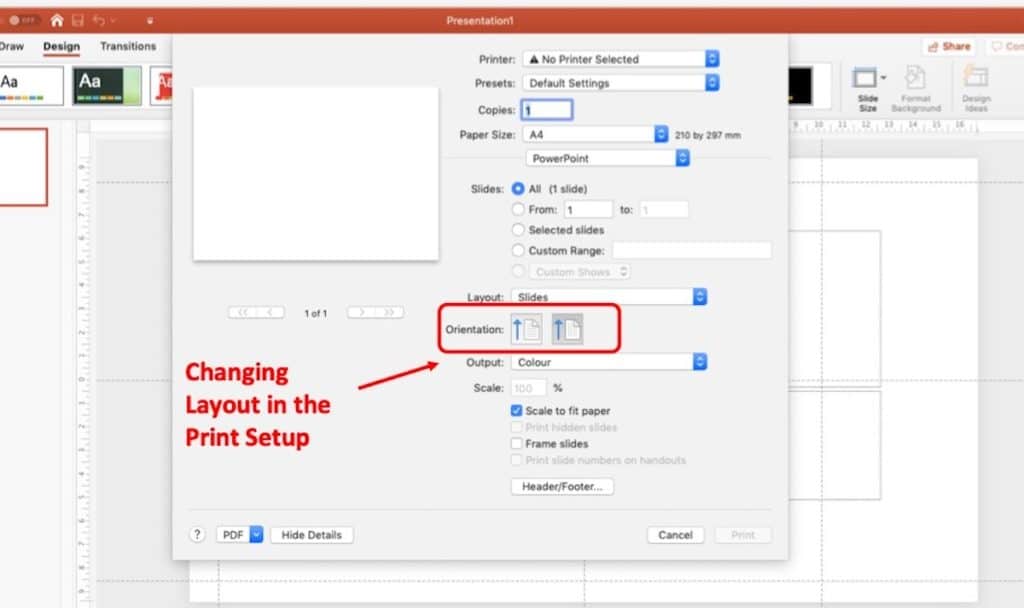
You can choose the appropriate orientation in which you would like to print your PowerPoint slides.

